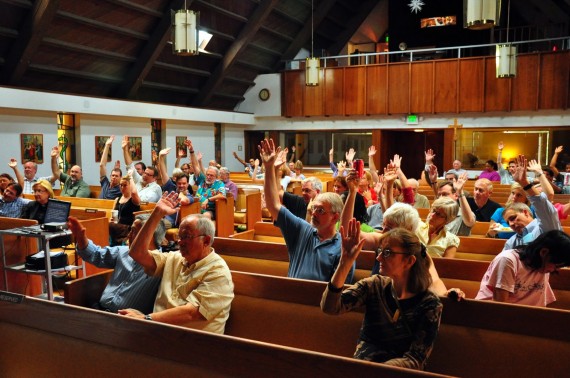Consensus-Seeking Phase
 Consensus decision-making calls for church members to let go of their vested interests and their personal agendas. They are encouraged to approach old and new ideas with openness, to talk about issues without being defensive. Working towards consensus becomes easier when everyone agrees to drop their prejudices and personal preferences and examine issues and ideas objectively. By doing this, we begin to separate legitimate needs from perceived or apparent needs. Legitimate needs are those that are not biased or selfish, and that look beyond immediate problems of the present. As we go through the process, these true needs emerge and gradually become obvious as being important to the whole community. The implementation of this consists of two discrete tasks:
Consensus decision-making calls for church members to let go of their vested interests and their personal agendas. They are encouraged to approach old and new ideas with openness, to talk about issues without being defensive. Working towards consensus becomes easier when everyone agrees to drop their prejudices and personal preferences and examine issues and ideas objectively. By doing this, we begin to separate legitimate needs from perceived or apparent needs. Legitimate needs are those that are not biased or selfish, and that look beyond immediate problems of the present. As we go through the process, these true needs emerge and gradually become obvious as being important to the whole community. The implementation of this consists of two discrete tasks:
- Development of Presentation Materials: Working with the Committee, the Architect will determine what presentation materials would be most helpful in communicating the concepts of the future Master Plan to the congregation. The necessary brochures and renderings needed for the consensus-seeking meeting will be developed and computer-generated graphics that help explain the project will be prepared. Finally, the work of the Committee will be presented to the congregation through a PowerPoint presentation describing the design.
- The Church-wide Consensus-Seeking Meeting: Along with one or two members of the Facilities Committee, the Architect presents the preferred alternative at the Church-wide Consensus-seeking meeting. In his presentation, he reviews the needs developed in the second phase of the process and demonstrates how the proposed solution meets these needs within the funding capability of the church. The presentation is followed by a question and answer period. Once all questions have been answered, a simple 2-question survey card is given to each attendee. These cards are filled out at the meeting so that by the end of the meeting, the architect and the Committee know whether or not they have consensus on the proposed Master Plan. If the Master Plan process has been well planned and executed, this is typically the easiest part of the whole process.
Please click here for the last in this series of posts on Master Planning.

1 Trackback